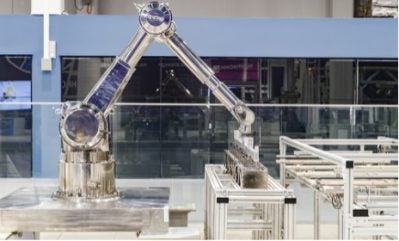
Russia intends to become a key international player with respect to the number of robots in industry, and their range targeting expansion from the current 10,000 to 95,000, Rosatom said. Rosatom Service, a robotics integrator, is beginning the systematic development of this new business for the nuclear industry.
Currently, the robotisation of the industry is being analysed by Rosatom’s Innokhub. Data has been completed for five divisions – fuel, electric power, mechanical engineering, environmental solutions and the nuclear weapons complex. Some 21 enterprises use 36 robotic systems – mainly manipulators (17) and mobile ones (7). Their implementation, as well as the selection of suppliers and the development of technical solutions, was an initiative of the management of the divisions and the enterprises themselves.
“We haven’t done this systematically,” Rosatom Director for Technological Development Andrei Shevchenko admitted. “Now the time has come, according to decisions at the state level, to build up technological sovereignty and create long-term demand for high-tech products in Russia. A new national project, ‘Means of Production and Automation’, is being launched, which is expected to receive formal approval from Prime Minister Mikhail Mishustin by the beginning of September.”
The budget is ready to allocate RUB300bn ($3.3bn) to the national project. Many European and Japanese manufacturers that previously supplied robots to Russian enterprises, including Rosatom, have left our market. In addition to the impossibility of new deliveries, this means the cessation of service support, and there is no guarantee that tomorrow some manipulator will not turn into a useless piece of metal, Rosatom noted. However, these gaps are rapidly being filled by manufacturers from China.
“There are Chinese robots on the Russian market, and they are quite good,” said Maxim Vinokurov, Deputy General Director of Rosatom Service in the Robotics department. “But the state wants to increase domestic production in such a way that by 2030 Russia will be among the top 25 countries in terms of the number of installed industrial robots.”
Given current needs, Rosatom is primarily focused not on service robots, but on industrial ones – programmable devices that carry out movement and control within the production process. However development plans have been drawn up. In six years, the industry aims to be producing 3,000 robots annually. Tasks to achieve this this goal include establishment of a competence centre and training centre, commercialisation of developments, import substitution, partnership, and opening a single window for developers and consumers.
“We are still at the stage of understanding the problems in the industry,” explained Vinokurov. “We know the situation in Rosenergoatom and in the fuel division, we see the needs of the Breakthrough project, we understand the need to design unmanned production facilities. But the overall picture for the industry is only just emerging.”
Robotic systems, mainly manipulators, are most urgently needed in the fuel division. About two hundred complexes are currently being implemented. However, Russian players in the robotics market are far from consolidated – there are about 200 mostly small firms. Fortunately, the nuclear industry has robotic competencies that will help cope with the urgent issues of import substitution and localisation of production, Rosatom said.






